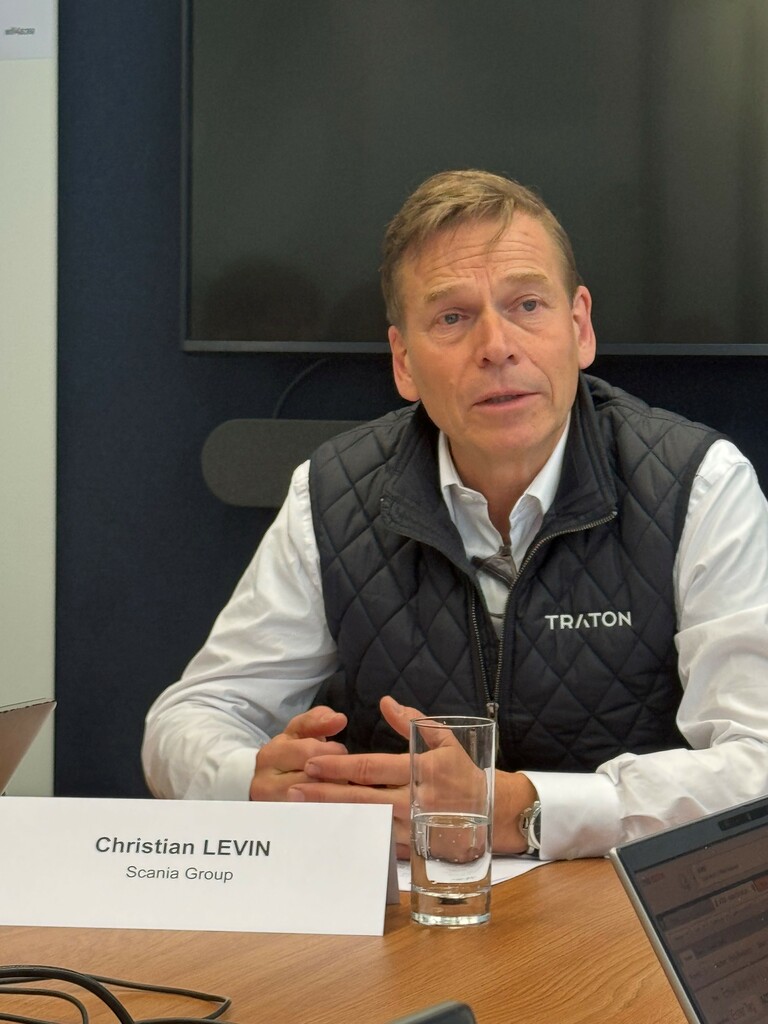
Hundreds of thousands of European jobs are at risk unless urgent action is taken to address the commercial vehicle industry’s inability to meet 2030 CO₂ reduction targets, according to Christian Levin, CEO of Traton Group and current chairman of ACEA’s Commercial Vehicle Board. Will Shiers, ITOY member for UK, reports.
Speaking in Brussels, Levin warned that Europe’s truck manufacturers “simply cannot carry” the billions of euros in fines they face if targets are missed, and that the consequences would ripple far beyond the factories. “We are the bloodstream of society,” said Levin. “Transport is the reason Europe is so efficient. If we lose our competitiveness as an industry, we will lose the jobs, the logistics capability, and the position we currently hold as global market leaders.”
Under current legislation, truck manufacturers must reduce fleet-average CO₂ emissions by 45% compared with 2020 levels by the end of this decade. Miss the target, and they face a penalty of €4,250 per gram of CO₂ per vehicle, with fines potentially reaching €1bn per OEM. “If we miss it by 10%, that’s where we end up,” Levin warned. “And not because we didn’t do our bit. The vehicles are ready. But if the other pieces don’t fall into place, we fail.”
Levin outlined four critical conditions that must all be met if the sector is to succeed: the trucks, the infrastructure, the business case, and the demand.
On trucks, the message is clear: European OEMs have delivered. Every major manufacturer now offers battery-electric heavy trucks for sale, and production capacity is in place. “We can guarantee that we deliver vehicles,” said Levin. “You place an order, you get a truck.”
Battery-electric vehicle sales currently account for just 3.5% of the EU heavy truck market - a figure that must rise tenfold by 2030. Not all of the 45% target is expected to come from electrification: around 10% will be delivered through improvements in drivelines and aerodynamics. But that still leaves battery-electric vehicles needing to make up the remaining 35% - within just four-and-a-half years.
Some EU markets, such as Sweden and the Netherlands, are leading the way, but others, such as Poland and Spain, remain far behind. “This isn’t a technology problem anymore,” said Levin. “It’s everything else.”
Infrastructure
The second hurdle is infrastructure. There are fewer than 1,000 locations in the EU where a heavy commercial vehicle can be charged, and most of those are not equipped with the megawatt chargers required by long-haul operators.
The real bottleneck, however, is grid connection. “Even in my home country of Sweden, it can take 10 years to put a cable in the ground,” said Levin. “This isn’t just about building chargers. It’s about getting power to them, and the permitting process is completely broken.”
For operators, switching to electric only makes sense if the business case stacks up, and today, it often doesn’t. “The diesel engine is still cheaper to run in most use cases,” Levin admitted. “We need to change that.” Solutions, he suggested, include a mix of carbon pricing, toll reform, tax breaks, and new financing models. “It’s absurd that fossil fuels are taxed less than electricity in Europe,” he added. “We need to make it more expensive to emit.”
Even with the right vehicles, the right infrastructure and the right TCO, fleet operators still need confidence that customers will pay, and keep paying, for low-carbon transport. “No one buys a truck for fun,” said Levin. “It’s an investment. And if your contract only lasts a year or two, how do you justify buying a €300,000 truck?” Longer-term contracts, clearer signals from government, and strong commitments from public and corporate buyers will all be needed. “Public procurement should demand zero-emission transport,” he said. “We have the supply. Let’s create the demand.”
Lack of dialogue
Despite the urgency, Levin expressed frustration at the lack of dialogue with the European Commission. “We are not passenger cars. It’s a completely different business model, and right now, we’re being left out of the conversation.” ACEA is now sending a formal letter to European Commission president Ursula von der Leyen requesting urgent talks and an early review of the 2030 target. “We [European truck makers] fully support the goal,” said Levin. “But without action on infrastructure, TCO and demand, we won’t get there, and the fines will do real damage.”
Levin believes Europe needs to take a tougher stance on legacy truck technology if it wants to meet its climate goals.
“From Euro-1 all the way to Euro-6e, the industry and legislators worked together,” he said. “We had clarity. When the new standard came in, the old one was banned. “You couldn’t register Euro-5 when Euro-6 came in. Basically, you closed the window,” he said.
He argues that the same principle should apply today, to encourage uptake of battery-electric trucks: “It must be the same with low or zero-tailpipe-emission vehicles. And that’s not the case in Europe, but that is the case in China.”
China, he noted, now has 30% electric truck penetration, driven by strong policy, swift regulation and targeted incentives, a contrast to Europe’s patchwork approach and slower pace. “We need to do something drastic,” he warned. “Otherwise, it’s four-and-a-half years to 2030. How should we go from 3.5% to 35%? It will simply not happen if we don’t change anything.”
